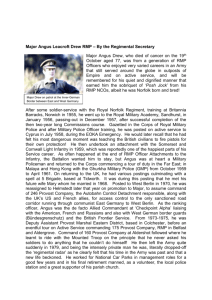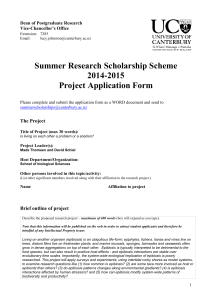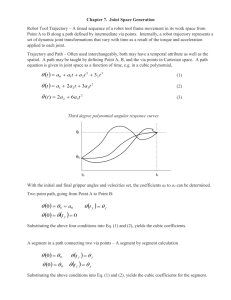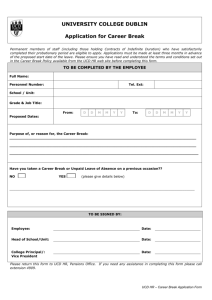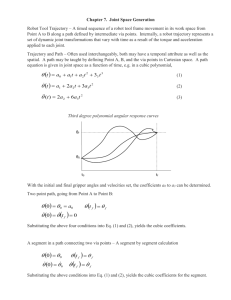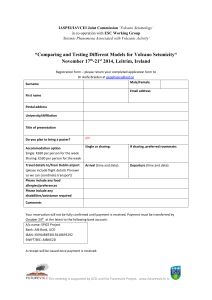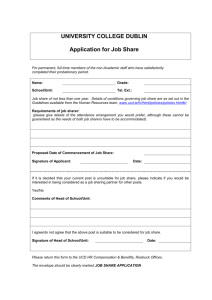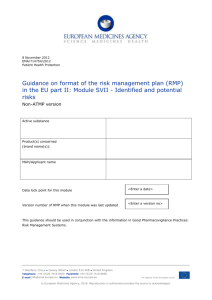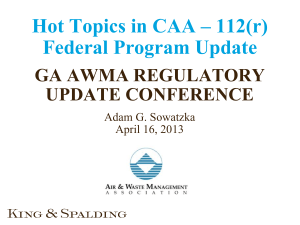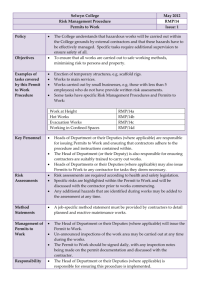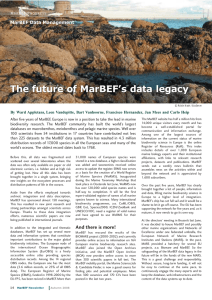report
advertisement
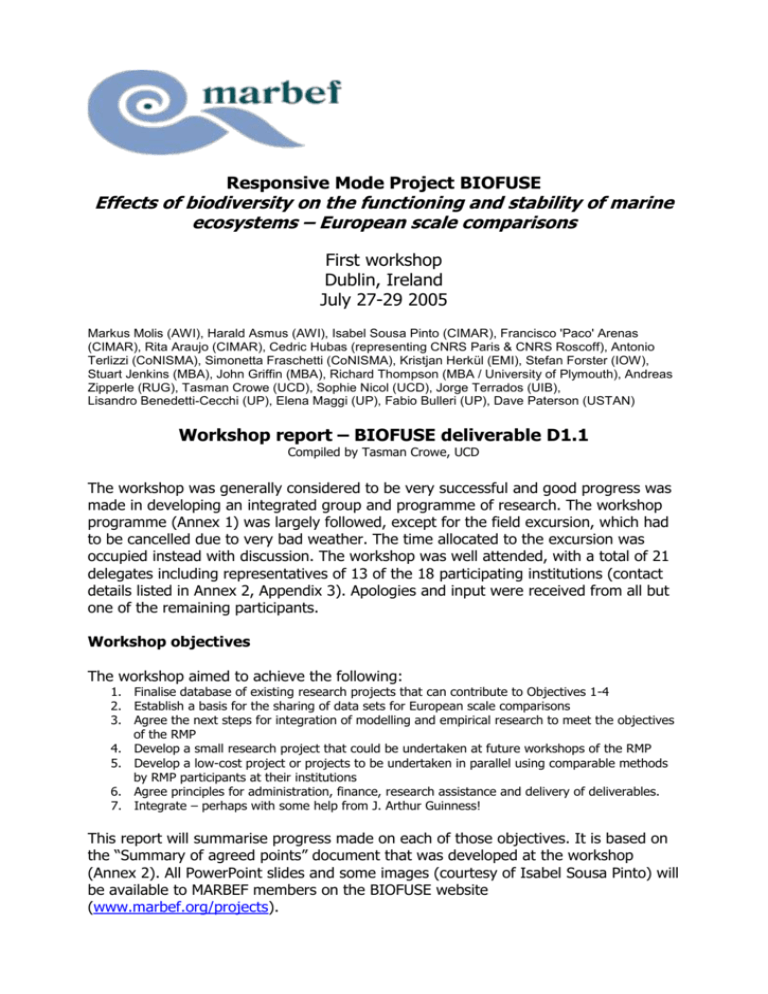
Responsive Mode Project BIOFUSE Effects of biodiversity on the functioning and stability of marine ecosystems – European scale comparisons First workshop Dublin, Ireland July 27-29 2005 Markus Molis (AWI), Harald Asmus (AWI), Isabel Sousa Pinto (CIMAR), Francisco 'Paco' Arenas (CIMAR), Rita Araujo (CIMAR), Cedric Hubas (representing CNRS Paris & CNRS Roscoff), Antonio Terlizzi (CoNISMA), Simonetta Fraschetti (CoNISMA), Kristjan Herkül (EMI), Stefan Forster (IOW), Stuart Jenkins (MBA), John Griffin (MBA), Richard Thompson (MBA / University of Plymouth), Andreas Zipperle (RUG), Tasman Crowe (UCD), Sophie Nicol (UCD), Jorge Terrados (UIB), Lisandro Benedetti-Cecchi (UP), Elena Maggi (UP), Fabio Bulleri (UP), Dave Paterson (USTAN) Workshop report – BIOFUSE deliverable D1.1 Compiled by Tasman Crowe, UCD The workshop was generally considered to be very successful and good progress was made in developing an integrated group and programme of research. The workshop programme (Annex 1) was largely followed, except for the field excursion, which had to be cancelled due to very bad weather. The time allocated to the excursion was occupied instead with discussion. The workshop was well attended, with a total of 21 delegates including representatives of 13 of the 18 participating institutions (contact details listed in Annex 2, Appendix 3). Apologies and input were received from all but one of the remaining participants. Workshop objectives The workshop aimed to achieve the following: 1. Finalise database of existing research projects that can contribute to Objectives 1-4 2. Establish a basis for the sharing of data sets for European scale comparisons 3. Agree the next steps for integration of modelling and empirical research to meet the objectives of the RMP 4. Develop a small research project that could be undertaken at future workshops of the RMP 5. Develop a low-cost project or projects to be undertaken in parallel using comparable methods by RMP participants at their institutions 6. Agree principles for administration, finance, research assistance and delivery of deliverables. 7. Integrate – perhaps with some help from J. Arthur Guinness! This report will summarise progress made on each of those objectives. It is based on the “Summary of agreed points” document that was developed at the workshop (Annex 2). All PowerPoint slides and some images (courtesy of Isabel Sousa Pinto) will be available to MARBEF members on the BIOFUSE website (www.marbef.org/projects). 1. Databases of existing data Spreadsheets containing metadata gathered prior to the workshop were circulated. The delegates divided into small groups on the basis of habitats of interest. Each group discussed what additional metadata would be necessary and compiled whatever information was available to them at the time. The results of these compilations will be available to MARBEF members in the data sets section of the BIOFUSE project website (www.marbef.org/projects/biofuse). It was agreed that we would aim to collate more metadata by requesting information from other MARBEF participants, particularly the Theme 1 leaders, who are also compiling potentially relevant data sets. Data sets from outside Europe would potentially be acceptable, as long as they are relevant to the comparisons being made. The final compilation of the datasets themselves will be done by the BIOFUSE postdoc. 2. Basis for sharing data sets The following basis was agreed upon: if data are used, each contributor will get the opportunity for coauthorship if they make substantive comments on the manuscript 3, 4 & 5. Agree the next steps to meet the objectives of the RMP Objective 1 – integrated descriptive research It was agreed that we need data-sets containing gradients of diversity and time series of measures of diversity, such that temporal variability (stability) could be plotted against diversity. We will also seek data sets with a functional component (relationships worth testing include: stability v diversity, stability of functioning v diversity, functioning v stability of community structure; variance in diversity v mean diversity). Each data set will contribute a regression coefficient to meta-analysis. Initial analyses to combine all data sets; subsequent analyses on selected subsets. There was some discussion in sub-groups about the possible influence of combining data sets with a range of temporal extents and intensities. It is possible that data sets with a very small number of points might be more likely to have high variance than data sets with many points and may thus introduce excessive noise into meta-analyses. This could be tested with larger data sets by deriving a clouds of variance values based on variances of all possible pairs of points, all possible triplets, quads, etc. This analysis could be used to develop criteria for acceptance of valid data sets (e.g. only use data sets with >3 temporal points). The original plan had been to subdivide the data sets on the basis of which gradient of stress was generating temporal variance. After discussion, stressors were not considered to be of key importance. Gradients of diversity might be generated by gradients of stress, however. There was discussion of the 2 potential for this to confound comparisons (e.g. apparent relationships between stability and diversity might actually be relationships between stability and stress). Lisandro emphasised that Objective 1 aims to describe patterns; a range of processes might underlie them and it would not be intended or possible that this analysis would discriminate between them. Others (e.g. Stuart) argued that it nevertheless be better to use data sets that contain variation in diversity not already known to be related to variation in other factors, e.g. by selecting sites of differing diversity but with similar levels of wave action, salinity, pollution, etc. Lisandro gave a presentation showing the use of PERMANOVA to extract a variance component for community structure which can then be plotted against the number of taxa in the community. Correlations were evident at the scale of individual quadrats, not at the scale of whole shores. Dave suggested testing ‘sampling effect’ in this context: removing some species (e.g. seasonal ones) from the data sets and test the effect of doing so on the relationship observed. Richard suggested that the scale-dependence of the relationship may vary at different locations. John expressed concern about the comparability of data sets with different temporal extents relative to the longevity of the organisms present. This discussion (and sub-group discussions) led to the suggestion that the importance of quadrat size and temporal extent and intensity be examined in supplementary studies. These would be done at workshops and as a specific sampling programme with fixed quadrats, randomly selected on rocky shores – fixed quadrats provide opportunity to assess small scale diversity-stability relationships, different shore heights provide opportunity for larger scale diversity gradient, range of shores provide even larger scale; select habitats likely to be variable over 2 year timescale. See Box 1 (below) for more details. Markus’ presentation reviewed the resources available to the project at AWI Biological Station, Helgoland: long history of research, datasets and ongoing projects (e.g. intertidal studies of recruitment, disturbance, invasion) support of a technician (~30%), PhD student, constant temperature rooms, laboratory space, research diver groups. Paco described data sets available from research in SW England & Spain on impacts of invasion and research in Portugal in the form of long term, large extent sampling of community structure on rocky shores (emergent rock and rock pools). In summary, Objective 1 of BIOFUSE will be achieved by: 1. Integrating existing data sets and using meta-analysis 2. Running a specifically designed long-term sampling programme in which most partners will participate 3. Running sampling experiments at forthcoming workshops, e.g. to test influence of ‘quadrat’ size and extent of sampling area on measures of temporal variation Box 1 (below) summarises the current status of plans for the long term sampling programme. These plans will be finalised at the second workshop so that the research can commence in Winter 2005-6. 3 Box 1 BIOFUSE Objective 1 – long-term sampling programme: Summary of current status of design Aims: 1. more specifically targetted / coherent examination of diversity-stability relationships than possible with meta-analysis of existing data; 2. provide basis to compare outcomes with those of meta-analysis to assess effectiveness of meta-analysis of disparate data sets. Focal habitat: rocky shores Participating institutions: UCD, UP, MBA, ConISMA, AWI, CIMAR, USTAN(?), CNRS(?), please add your institution to the list… Design: 5 sites selected to maximise likelihood of differences in diversity (e.g. along gradient of stress – wave exposure, pollution, etc or with different recruitment regimes). Sites of size 10s of m, 100’s m to km apart. Ideally sample rock pools and emergent rock at each site. Otherwise chose one or the other depending on overall availability. 2 shore heights – mid shore and low shore (where bands are large, select upper part of each band). Fixed sampling units randomly selected. Size of sampling unit can vary between partners. e.g. on emergent rock: Mediterranean 20 x 20 cm quadrats, Atlantic 50 x 50 cm quadrat. 5 quadrats, grid of 25 squares used to give visual estimate to nearest 5 % cover. Issue perhaps requires further discussion / supplementary study? Any comments? 2 samples per year (ie every 6 months) for 2 years commencing Winter 2005-6. Taxonomic resolution: best possible resolution achievable non-destructively in the field, including macrofauna (visible to naked eye). Issue perhaps requires further discussion? e.g. to what extent might discrepancies between data sets reduce the validity of comparisons among them? Any comments? Issues raised after main group discussion by remaining researchers: Can we in some situations revert to using individual sites as smallest unit in the metaanalysis (rather then regression coefficients from datasets)? In that way, all sites with all stressors would contribute a point to the graph/analysis and the influence of individual gradients would be diminished (lost?). Would this have the consequence of requiring much more stringent guidelines for standardised taxonomic resolution? 4 Objectives 2-4 – integrated experimental research Elena described a complex experimental test of the biodiversity-stability relationship based on assemblages constructed using Stachowicz’s tile approach and using Lisandro’s published designs for diversity manipulations and disturbance regimes. Stuart discussed the use of rock pools as experimental model systems to test hypotheses about the relationship between biodiversity and ecosystem functioning. Three studies were summarised: (a) functional diversity v susceptibility to invasion, (b) grazers and/or nutrients v cover of ephemeral alga and productivity and (c) combining observation, modelling and experimentation. Paco showed that the identity rather than number of functional groups of algae affected the susceptibility of rock pools to invasion. Kristjan summarised a number of experiments in Estonia that may contribute to BIOFUSE. The experiments involved mesocosms in the form of cages suspended from floating rafts and tested (a) the role of functional diversity in the stability and development of benthic communities, (b) the effect of suspension feeding bivalves on the development of benthic assemblages and (c) effects of physical and biological disturbance on the recolonization and development of benthic assemblages. Cedric presented relevant research by CNRS, including a purpose-built benthic incubator for measuring various aspects ecosystem functioning. Harald described biodiversity-ecosystem functioning research in the Sylt-Rømø bight. There is a long history of research including long term data sets on a wide range of taxa and physical variables together as well as experiments involving bell jar chambers and flumes. Network analysis was presented as one approach to drawing this information together. We agreed four aspects of integration of experimental work: 1. meta-analysis of existing data as appropriate; 2. minor modifications to existing projects to improve comparability; 3. ‘simple’ manipulations of key taxa crossed with disturbance to be done by most partners (rocky shores, sedimentary shores, seagrass – see Figure 1 and details below); 4. ‘complex’ experiments designed to discriminate between effects of number, identity and relative density of taxa on ecosystem functioning and stability. These experiments would require a minimum of 12 treatments, ideally 16 (as presented by Lisandro, based on Benedetti-Cecchi (2004) Funct. Ecol. 18: 761768 (MARBEF publication series www.marbef.org/documents)). Such experiments would be done by a small number of partners with sufficient additional resources (6 partners expressed interest: focussing on rocky shores (pools, emergent substrata?) - AWI (Markus), USTAN (Dave), CIMAR (Isabel), ConISMA (Simonetta), UP (Lisandro), UCD (Tasman) and sedimentary habitats - USTAN (Dave). The ‘simple’ deletion experiments would test the effect on ecosystem function and stability of factorial removal of a small number of key taxa/functional groups. Selected taxa would vary among habitats (final decisions to be made by module 5 leaders) and might include canopy algae, mussels, seagrass, Corophium. Stability would be tested in the face of disturbance regimes such as thermal stress, mechanical stress (e.g. bioturbation, trampling, boulders), sedimentation, nutrient pulses, hypoxia, salinity (e.g. add salt or freshwater). Target variables could include simple measures such as change in biomass or change in community composition and more complex measures such as community respiration, production (e.g. as measured using benthic incubation chambers described by Cedric and Harald). Listed below are some combinations of taxa and disturbance proposed for different habitats: Sedimentary shores Manipulate: burrowing worms (Arenicola, Nereis) using buried mesh Disturbance: trampling / bioturbation (short-term study, 2-3 months) Measure: community structure, biomass accumulation, community respiration etc (measured with incubation chamber). Rocky shores Manipulate: canopy algae, mussels Disturbance: sedimentation Measure: community structure, biomass accumulation, community respiration etc (measured with incubation chamber). Sea grass Manipulate: Zostera noltii / marina (leave algae in place) Disturbance: mechanical – waves, currents, sediment displacement Measure: cover of macrophytes & associated fauna, biomass accumulation, oxygen fluxes, nutrient fluxes Harald suggested mussels and canopy algae could be manipulated in both soft and hard substrata to enable some direct inter-habitat comparisons. 6 Rocky Sediment Seagrass Location correct? ? Figure 1. Some possible locations for ‘simple’ experiments on rocky shores, sedimentary shores and sea grass beds (as indicated by workshop delegates). Modelling Given the lack of modellers in the final group of participants, we agreed that we could not achieve the original aspiration of combining empirical work and modelling within BIOFUSE. We will therefore focus on empirical work and there will be no substantial modelling component in BIOFUSE. Instead, steps towards integration will be taken by developing links with the modelling RMP. Harald agreed to take the lead in this. 6. Finance and administration Support for postdoctoral research assistant €103k has been committed as contributions towards pooled staff / equipment (see Table 1). We will recruit a 3 year post-doc to be based for 1.5 years at UCD and 1.5 years at UP. 7 Their tasks will be to collate existing data sets and build fully functional database; meta-analysis; co-ordinate integrated research projects; take lead in authorship of some of the combined papers. Over the 2 weeks following the workshop, financial contributions of partners were finalised. Participants were asked to check Annex 2, Appendix 2, especially the final column in the table, and to send amendments to T. Crowe. Amendments were received and the table has been updated (Table 1). Partners contributing to the postdoc will be invoiced by UCD / UP (invoice to state its purpose: postdoc, and not to include overhead, so overhead can be claimed by contributing partner). The position was advertised in August. The advertisement was distributed via MARBEF website, email discussion lists and personal email distribution lists. Table 1. Finalised budgetary commitments from partners (in €k). Partner ID Partner Own MARBEF MARBEF resources Basic Additional 1 NIOO-CEME 10 9 13 4 CSIC 5 USTAN 13 IOPAS 14 AWI 15 AAU 20 IOW 22 CoNISMa 24 UCD 26 RUG 32 CIMAR 39 IOUG 42 IMBC 43 MBA 52 UP 44c CNRS Roscoff 44e CNRS Paris 4.5 30 2 4.1 20 15.25 4 57 0 36 8 32 4 3.8 30 6 19 31 2 8 8 1 0 6 1 2 7 0 4 20 3 50 15 36 9.34 316.19 4 2 8 26 7 6 205.8 2 6 3 2 53 TOTALS *PhD student and technician's time committed to BIOFUSE ** postdoc's time committed to BIOFUSE MARBEF Total 22 8 40 5 3.8 36 7 21 38 2 12 4 2 10 32 10 8 260.8 Support for shared Overall post-doc / equipment? Total Amount of contribution 32 12.5 70 7 7.9 56 22.25 25 95 2 48 24 5 60 47 46 17.34 576.99 40 * 15 6 20 ** 1 4 16 1 103 Module leaders Rocky shores: S Jenkins Sedimentary: D Paterson Seagrass: J Terrados Modelling liaison: H Asmus Outreach: S Fraschetti Next full workshop At the end of the workshop, it was agreed that the workshop would take place as planned in March / April 2006; Cedric Hubas was to investigate possibility of 8 it being hosted in Roscoff; MBA, Plymouth was proposed as a possible alternative. It was agreed that we’d probably need smaller workshops before then e.g. to develop protocols and equipment (e.g. incubator). After the overall group disbanded, it was suggested that the full workshop be brought forward in time (e.g. January 2006). This would avoid the need for smaller workshops and enable sampling for Objective 1 to be agreed and commenced in winter 2005-6 and give the maximum possible time to prepare for experiments to meet Objectives 2-4, which will be initiated in summer 2006. It was also suggested we go further south at that time of year. After wider consultation, it was agreed that the second workshop will be hosted by CIMAR in Viana, near Oporto, Portugal on 12-14 January 2006 (see www.ciimar.up.pt/biodiversidade/LBCViana.htm). A future workshop will be hosted by CNRS Roscoff. AOB Andreas was not present to describe GBIRM in detail, but the potential for links between the RMPs was stressed (see supporting documentation to the programme (Annex 1). Isabel indicated that the Congress of Conservation Biology would take place in August 2006 and would include a MARBEF session on Conservation of Marine Biodiversity. A number of delegates agreed to give talks in that session. Dave pointed out that there will be a training workshop on ecosystem functioning at USTAN Outreach – presentation by Olive Heffernan; there was agreement that each participant contribute at least one piece of outreach material during the RMP. 7. Integration The workshop generated good interaction among the delegates, with active, inclusive discussions. Original plans to subdivide into small groups based on habitats were shelved in favour of whole group discussions, giving a much higher level of integration. The social events were enjoyed by all. There was a strong sense of momentum and optimism at the end of the workshop, suggesting that BIOFUSE should be a successful and productive RMP. 9 Annex 1 – workshop programme Responsive Mode Project BIOFUSE Effects of biodiversity on the functioning and stability of marine ecosystems – European scale comparisons First workshop Dublin, Ireland July 27-29 2005 Workshop objectives: 8. Finalise database of existing research projects that can contribute to Objectives 1-4 9. Establish a basis for the sharing of data sets for European scale comparisons 10. Agree the next steps for integration of modelling and empirical research to meet the objectives of the RMP 11. Develop a small research project that could be undertaken at future workshops of the RMP* 12. Develop a low-cost project or projects to be undertaken in parallel using comparable methods by RMP participants at their institutions* 13. Agree principles for administration, finance, research assistance and delivery of deliverables. 14. Integrate - perhaps with some help from J. Arthur Guinness! * Such projects should yield deliverables under the stated Objectives of the RMP. Deliverables specified in the RMP work package description - D1.1: Report of kick-off workshop with the identification of: (i) testable hypotheses on biodiversity-stability relationships, including appropriate response variables and measures of ecosystem functioning (ii) types of analyses on existing data sets, (iii) types of models (iv) types of experimental designs 10 Wednesday 27 July Morning session 1 (9.00 – 11.00) Chair: Tasman Crowe Welcome and Introduction Focus on Objective 1 – quantifying stability at sites of naturally differing diversity and exposure to disturbance. Discuss the metadata on existing sampling programmes already collated Include some short presentations (5-10 minutes) about existing data sets or sampling programmes to help stimulate discussion. o Lisandro Benedetti-Cecchi (UP): Temporal variability in assemblages of rocky seashores in relation to natural and anthropogenic disturbance o Markus Molis (AWI): Research on diversity drivers of rocky shore macrobenthic communites on the island of Helgoland o Francisco Arenas (CIIMAR): Rocky shore data sets from CIMAR Decide whether there are gaps which we could aim to fill by initiating additional low cost sampling programmes. 11.00 – 11.20 Coffee Morning session 2 (11.20 – 1.00) Objective 1 (continued). Discuss basis on which data sets can be used for European scale comparisons, including initial discussion of joint publications and authorship. Break into smaller groups (e.g. according to habitat or focal disturbance type) to discuss more specific details of the data sets – e.g. based on availability of data, which specific hypotheses can be tested, using which kinds of designs and analyses. 1.00-2.00 Lunch Afternoon session 1 (2.00 – 3.30) Chair: Lisandro Benedetti-Cecchi Focus on objectives 2-4 – experimental research to test relationships between biodiversity and the functioning and stability of ecosystems. Discuss existing projects and scope for integration of findings Include some short presentations (5-10 minutes) on existing research to help stimulate discussion o Elena Maggi (UP): Manipulation of the number,identity and equitability of species on rock surfaces: effects on succession and relevance for the analysis of biodiversity-stability relationships o Stuart Jenkins (MBA): Biodiversity and ecosystem functioning in rock pools o Francisco Arenas (CIMAR): Diversity-invisibility relationships in rock pools o Kristjan Herkül (EMI): Recent experimental studies on the relationships between ecosystem function and benthic diversity in the Estonian coastal sea o Harald Asmus (AWI): Flumes, models and fluxes - effects of biodiversity on the functioning and stability of seagrass and mussel bed systems Discuss the integration of modelling and empirical (lab and field) approaches 11 3.30 – 4.00 Coffee Afternoon session 2 (4.00 – 5.30) Objectives 2-4 (continued) Break into small groups as necessary (e.g. combining modellers and empiricists working on same habitats or combining lab- and field-based empiricists working on same habitats) to discuss more specific details of integration and to deliver some specific hypotheses and summaries of modelling approaches, experimental designs, protocols and response variables. Adjourn to a nearby pub, plans for dinner at discretion of participants Thursday 28 July Visit to Sea Point, a shore in Dublin Bay with natural and artificial hard substrata and extensive soft substrata. Opportunity to develop ideas for collaborative research and discuss practical issues in sampling and experimental manipulation. Bring sampling protocols and equipment, including any prototypes in development. Low tide is at 11.09, depart Dublin by DART at 9.15 to arrive on shore by 10.00. Stay until 12.30 (approx.). Lunch at the Purty Kitchen – a good pub within 15 minutes’ walk of the shore. Afternoon session (3.30 – 5.30) Chair: Tasman Crowe Overall introduction (inlcuding brief description of GEBIRM by Andreas Zipperle), followed by small group discussions on: The potential to develop a project linking expertise from BIOFUSE and GEBIRM (another RMP, focussed on genetic diversity). See ‘supporting documentation’ (No. 1) below. The development of a specific piece of research that could be completed at a given site within 1-3 days such that it could be executed by participants at future workshops of the RMP, taking advantage of the numbers and combined skills of those present – a Workshop Research Project. Developing a position statement on the interpretation of best practice in terms of experimental design and analysis (MARBEF core deliverable D1.5) 7.30 Workshop dinner Friday 29 July Morning session 1 (9.00 – 11.00) Chair: Stuart Jenkins 12 Discuss longer term, low cost research that could be executed by RMP participants at their research institutions during the course of the RMP. Such research would capitalise on the large number of institutions involved and the opportunity to create a substantial piece of focussed research with minimal cost to any one institution. Discuss development of proposal for additional funding. Continue discussions initiated on previous days. 11.00 – 11.20 Coffee Morning session 2 (11.20 – 1.00) Chair: Tasman Crowe Financial, administrative and other issues, including: agree principles for sharing of data sets / authorship, etc. support for postdoctoral / postgraduate research assistants to assist in integrative research confirmation of module leaders and individuals / teams responsible for deliverables outreach – comments from Simonetta Fraschetti and Olive Heffernan date and venue of next workshop(s) any other business concluding remarks, including summary of agreed points 1.00 – 2.00 Lunch Afternoon session (2.00 – 4.00) Opportunity for small group discussions about specific issues arising during the workshop and to complete tasks initiated earlier in the workshop. 13 Annex 1 (contd.) - Supporting documentation 1. Correspondence in relation to development of experimental manipulation of genetic diversity March 2004 – from Ester Serrao Report on discussions concerning cross-cutting approaches within RMPs on Genetics (GBIRM) and Experimental (BIOFUSE) approaches 1. It was decided to integrate again an experimental approach to assessing relationships between genetic diversity and ecosystem stability, as had initially been proposed during the planning stages of Marbef. 2. - Genotypic diversity (= clonal diversity) was selected as the variable to be manipulated, for simplicity in the initial studies. Other genetic diversity aspects were discussed and might be considered later on. Therefore clonal species with availability of good markers capable of distinguishing genets, must be selected as models. The two model types selected were therefore: - Animal model: (suggestions by Steve Hawkins) colonial bryozoans (to be discussed with Roger Hughes) or colonial tunicates (to be discussed with John Bishop), selected due to easiness of application of manipulative approaches. - Primary producer model: a clonal plant or seaweed: Zostera noltii was selected due to (among other reasons): - broad distribution across European coasts - availability of markers - feasibility of manipulative approaches in the field. Stress factors to be manipulated for Z.noltii: sediment burial, intertidal exposure, temperature. July 2005 – from Jeanine Olsen Dear Tasman and Lisandro: As you know the kick off meeting of GEBIRM was held in Marseille last week. There will be an official report coming from Jean-Pierre and Anne but I'd like to fill you in on a couple of highlights that may be relevant for discussion during the Dublin meeting. Unfortunately, I will not be able to attend, but am sending my PhD student Andreas Zipperle (works on Zostera noltii in Sylt and is part of our Zostera team). Sophie Arnoud was going to try and come or at least have contact with CarlosD beforehand. Onno Diekmann will talk to Ester Serrao who may be able to come. I don't think there's anyone else. The point is, we are interested but we are not yet properly coordinated with BIOFUSE. QUICKIE REPORT: Macrophyte cluster people at GEBIRM were: RUG. Jeanine Olsen, Wytze Stam, Jim Coyer, Andreas Zipperle. I am coordinator of the macrophyte cluster within GEBIRM although Jean-Pierre is the big boss. SZN. Gabrelle Procaccini UIB (Carlos Durate's group). Sophie Arnaud ROSCOFF. Thierry Comtet (representing Myriam Valero who could not come) UGOT (Tjarno). Carl Andre. CCMAR (Faro,Porto). Onno Diekmann (Zn person) Taxa. From a list of 17 macrophyte species we ranked our top 5 and then second top 5 and then an invasives group. Crieteria for the top group were a combination of geographic coverage available, present of msat loci and large data sets for multi-species phylogeographic comparisons. Criteria for the second group were somewhat more relaxed. Invasavis mainly for eventual coordination with Theme 3 (mgmt). Results were: Top 5 [actually 6] (no order within): Zostera noltii, Z. marina, Posidonia, Cymodosia, Fucus vesiculosus and F. distichus. 14 Second top (no order): Fucus spiralis, Fucus serratus, Laminaria digitata, Aspargopsis taxiformis, Caulerpa prolifera Invasives (order important in this case): Undaria, Caulerpa racemosa, Aspargopsis armata, Caulerpa taxifolia. Funds. The total monies available for the macrophyte cluster for work is around 50K after we reserve travel monies to workshops and so on. so, not enough for personnel (which was a point of discussion). It was decided (the invert and fish clusters too; the also have about 50K each) that the best general way to spend the money is to fill in sampling gaps through mini-expeditions/collecting trips. For example, one area that is a hole for almost everyone (regardless of group) is the eastern Mediterranenan (Greek, Turkish coasts, Middle East; also Black Sea for some people). Other areas are parts of the north African coast, northern Scotland and Siberia (east of the White Sea). Task teams will begin to investigate the possibiliites for joing forces with local marine labs, getting permits (a particular problem in Greece and Turkey), estimates of boat hires and so on. So, within GEBIRM we will be starting to see what sorts of collecting trips can be planned. Cross-cutting RMP. Recall too that GEBIRM is also a cross-cutting RMP with links to themes 1 and 2. As I understand it, there was a discussion at the Tevira meeting about the possibility of manipulating genetic diversity in some of the planned experiments and Zostera noltii was mentioned. We support this. If there are disucssions about experiments involving fucoids for which msat genotyping and chararacterization of areas would be of interest, that can also be arranged depending upong the scope of things....remembering that there's not much money. These two items would serve as a cross-cutting theme topic and we might also be able to get modest support from core Marbef funds. So, in short, the macrophyte cluster within GEBIRM is keen to integrate where appropriate. The thing is, we are not sure who from GEBIRM will be able to actually attend BIOFUSE-Dublin. As I said, Andreas will come (assuming he has been accepted) and hopefully someone from Ester's and Carlos's group. I hope this is sufficient information for now. Jeanine July 2005 – from Carlos Duarte Dear all, It is my understanding that the experimental evaluaiton of the role of genetic diversity on ecosystem function was not going to be conducted as an addition to the RMP. Indeed, in a document under consideration by the governing bodies of MARBEF, which I prepared some months ago, I requested specific funds to run these experiments as part of the future activities on the JPA for the remaining of the project, the rationale being that the RMP does not have enough resources to add new work not planned in the initial submission of the RMP. However, I have not yet received any indication from the governing bodies as to whether this specific request will be supported or not. Best regards, Carlos M. Duarte July 2005 – from Gabriele Procaccini 15 Dear all, this just to say that we (SZN) are potentially interested to be involved in the Z. noltii manipulation experiments. Ischia could be a backup site (different depth, conditions, etc...) although it really depends from several factors such as the possibility to replicate the experiments (that I imagine have been planned in the intertidal), funds, etc... No possibility for us to go to Dublin. ciao Gabriele 2. Q & A with management office about finances (replies from management office prefixed by ‘MO:’) 1. Is there a formal process to draw down funds in relation to RMPs or will the next payment automatically be transferred from MARBEF to the institution? If there is a process, I'd be grateful if you could advise me on how it works - e.g. is there an official application form? MO: The annual refunding depends on the (eligible and agreed) costs that you made in that year (to be mentioned in the Cost Statement). Nothing more nothing less. There is no special treatment for costs associated with RMPs (no lump-sum payments, no pre-payments). 2. Within an RMP, if we (the participants) elect to pool some of our resources, for example to support a postdoc, what is the correct way to do it? I guess the postdoc would be paid through a host institution (even if they travel between insitutions for extended periods). In that case, should that host institution invoice each of the contributing participants for their agreed contributions? Are there alternatives? I ask because this will be one of the points of discussion at the first workshop of RMP 4-4 (now called BIOFUSE) to be held on 27-29 July in Dublin. MO: There are no special rules for pooling money for a post-doc or PhD. In other RMPs similar questions came to the foreground. Your solution of sending an invoice to the participating institutions was until now similar to the best solution I've heard (I proposed it also to GBIRM). You should take care about the fact that the invoice should be free of overhead - in that way the participating institutions can still ask for their own overhead (on the basis of the value of the invoice they have paid to the host institution). To my knowledge there are no good alternatives. 3. In hosting a workshop, I assume a suitable procedure to recover expenses, eg. for catering, etc., would be to charge a 'registration fee' to each participant, by invoicing their institutions. Am I correct in this assumption? MO: you are fully correct. 4. I couldn't find any official minutes from the Porto GA on the website. Could you let me know the official decision on what happens to unspent funds at the end of the initial 18 month period? Will they be reclaimed into the central budget or will some or all of the money potentially be available to support aspects of the RMP? MO: You are again correct - the minutes are not published yet (will follow soon). There is no decision on unspent funds. A decision will be made in September (at the SSC/EC meetings in Barcelona). We are now preparing criteria in order to evaluate what to do with unspent funds. The general idea is that partner that performed properly, and have spent more than 15 kEuro can spent the remaining funding for other (e.g. RMP) activities in the following years. All others will be asked to explain why they under-spent. In case partners do not need so much, or fail to be more active, we will reallocate part of their funding towards the central budget - this last will 16 be especially for those who spent les than 5 kEuro and hardly participated in any activity. But, mind that this is still in preparation. 3 Outreach guidelines (from Olive Heffernan, MARBEF outreach officer) MarBEF RMP Outreach Guidelines 1. Identify one contact within the RMP who will act as a media/outreach liason This will involve feeding information from the project to the Communications and Outreach Officer as and when necessary and handling media enquiries or providing information for media relations should the need arise 2. All RMP participants to fill out attached form identifying areas of expertise and email to Communications and Outreach Officer 3. Identify target audiences for outreach. Progress and outcome of the project should be published to the scientific public, the public at large, the media, stakeholders and end-users (communication with Theme 3), where appropriate. For example, is the project to have any likely implications for or be of interest to: industry e.g. fisheries, aquaculture Policy/decision makers/environmental managers Users of marine resources 4. Identify your key messages and make format appropriate for target audience-liase with Communications and Outreach Officer 5. Identify target media appropriate to your outreach; this will depend very much on the audience e.g. MarBEF newsletter, website, symposium session for scientific community, trade magazines for industry, distribution of news releases through Press Office for media etc 6. Identify timeframe (deadlines) and budget for outreach activities 7. Identify other RMPs where outreach activities or material could overlap 8. Draft list of minimum outreach activities/contributions for the lifespan of the project e.g. a. 2 articles for the MarBEF newsletter b. One page or ‘topic note’ on the outreach website c. Publicity material on project? Posters? Flyers? d. Supply of images and other media where possible for outreach site and for events e.g. MarBEF roadshow 9. Individual Communications/Media contacts within each RMP will be responsible for writing their own releases; the outreach officer can be contacted for editorial assistance where necessary. The MarBEF Press Office will distribute press releases Europe-wide through Alpha Galileo and where necessary internationally through EurekAlert! 17 Annex 2 - Summary of agreed points Databases of existing data TC to compile and circulate current versions (with additional columns for details of scale etc) to MARBEF (incl. Theme 1 leaders) and other potential contributors, requesting required meta-data for additional data sets BIOFUSE post-doc to compile the data sets Basis for sharing data: if data used, each contributor will get the opportunity for co-authorship if they make substantive comments on the manuscript Objective 1 Need data-sets with gradient of diversity and time series of measures of diversity; plot temporal variability v diversity; will also seek data sets with a functional component (relationships worth testing include: stability v diversity, stability of functioning v diversity, functioning v stability of community structure; variance in diversity v mean diversity) Each data set will contribute a regression coefficient to meta-analysis Initial analyses to combine all data sets; subsequent analyses on subsets Stressors not of key importance Importance of quadrat size and temporal extent and intensity to be examined in supplementary studies (at workshops and specific sampling programme with fixed quadrats, randomly selected on rocky shores – fixed quadrats provide opportunity to assess small scale diversity-stability relationships, different shore heights provide opportunity for larger scale diversity gradient, range of shores provide even larger scale; select habitats likely to be variable over 2 year timescale. See Appendix 1). Objectives 2-4 4 aspects of integration 5. meta-analysis of existing data as appropriate 6. minor modifications to existing projects to improve comparability 7. ‘simple’ manipulations of key taxa crossed with disturbance to be done by most partners (rocky shores, sedimentary shores, seagrass) 8. ‘complex’ experiments (minimum 12 treatments, ideally 16, as presented by L Benedetti-Cecchi, based on paper in Functional Ecology 2004) to be done by small number of partners with sufficient additional resources (approx. 6 partners expressed interest, focussing on rocky shores (pools, emergent substrata), sedimentary habitats). Modelling No major concerted effort on modelling as part of BIOFUSE Instead develop links with the modelling RMP 18 Finance and administration Support for postdoctoral research assistant €103k committed as contributions towards pooled staff / equipment (see Appendix 1) Recruit 3 year post-doc to be based for 1.5 years at UCD and 1.5 years at UP Tasks: collate existing data sets and build fully functional database; metaanalysis; co-ordinate integrated research projects; take lead in authorship of some of the combined papers. Over next 2 weeks will finalise agreed financial contributions of partners (check Appendix 1, especially final column in table, and send amendments to T. Crowe). They will then be invoiced by UCD / UP (invoice to state its purpose: postdoc, and not to include overhead, so overhead can be claimed by contributing partner). Position to be advertised in next few weeks and in post as soon as possible. Advertisement to be distributed via MARBEF website, email discussion lists, jobs.ac.uk, personal email distribution lists. Module leaders Rocky shores: S Jenkins Sedimentary: D Paterson Seagrass: J Terrados Modelling liaison: H Asmus Outreach: S Fraschetti Next full workshop AOB March / April 2006; Cedric Hubas to investigate possibility of it being hosted in Roscoff; MBA, Plymouth proposed as a possible alternative. Suggest smaller workshops before then e.g. to develop protocols and equipment (e.g. incubator) Alternatively (suggested after overall group disbanded): why not bring full workshop forward in time (e.g. to beginning of January? Better to go further south at that time of year?). Links with GBIRM and potential for combined project Congress of Conservation Biology Forthcoming training workshop on ecosystem functioning at USTAN Outreach – presentation by Olive Heffernan; agreement that each participant contribute at least one piece of outreach material during the RMP. Draft full report of workshop to be circulated within next 2 months, workshop materials (e.g. powerpoint presentations) to be placed on MARBEF website ASAP. 19 Annex 2, Appendix 1 - outline of long-term monitoring programme (part of Objective 1) Aims: 1. more specifically targetted / coherent examination of diversity-stability relationships than possible with meta-analysis of existing data; 2. provide basis to compare outcomes with those of meta-analysis to assess effectiveness of meta-analysis of disparate data sets. Focal habitat: rocky shores Participating institutions: UCD, UP, MBA, ConISMA, AWI, CIMAR, USTAN(?), CNRS(?), please add your institution to the list… Design: 5 sites selected to maximise likelihood of differences in diversity (e.g. along gradient of stress – wave exposure, pollution, etc or with different recruitment regimes). Sites of size 10s of m, 100’s m to km apart. Ideally sample rock pools and emergent rock at each site. Otherwise chose one or the other depending on overall availability. 2 shore heights – mid shore and low shore (where bands are large, select upper part of each band). Fixed sampling units randomly selected. Size of sampling unit can vary between partners. e.g. on emergent rock: Mediterranean 20 x 20 cm quadrats, Atlantic 50 x 50 cm quadrat. 5 quadrats, grid of 25 squares used to give visual estimate to nearest 5 % cover. Issue perhaps requires further discussion / supplementary study? Any comments? 2 samples per year (ie every 6 months) for 2 years commencing Winter 2005-6. Taxonomic resolution: best possible resolution achievable non-destructively in the field, including macrofauna (visible to naked eye). Issue perhaps requires further discussion? e.g. to what extent might discrepancies between data sets reduce the validity of comparisons among them? Any comments? Issues raised after main group discussion by remaining researchers: Can we in some situations revert to using individual sites as smallest unit in the metaanalysis (rather then regression coefficients from datasets)? In that way, all sites with all stressors would contribute a point to the graph/analysis and the influence of individual gradients would be diminished (lost?). Would this have the consequence of requiring much more stringent guidelines for standardised taxonomic resolution? 20 Annex 2, Appendix 2 – budget and commitment of resources to shared staff / equipment Budgetary commitments (€k) - figures taken from RMP workpackage description / earlier correspondence Partner ID Partner 1 NIOO-CEME 4 CSIC 5 USTAN 13 IOPAS 14 AWI 15 AAU 20 IOW 22 CoNISMa 24 UCD 26 RUG 32 CIMAR 39 IOUG 42 IMBC 43 MBA 52 UP 44c CNRS Roscoff 44e CNRS Paris TOTALS Own MARBEF MARBEF resources Basic Additional 10 9 13 4.5 30 2 4.1 20 15.25 4 57 0 36 8 32 4 4.1 30 6 19 31 2 8 8 1 0 6 1 2 7 0 4 20 3 50 15 36 9.34 316.19 4 2 8 26 7 6 206.1 2 6 3 2 53 MARBEF Total 22 8 40 5 4.1 36 7 21 38 2 12 4 2 10 32 10 8 261.1 Support for shared Overall post-doc / equipment? Total Amount of contribution 32 12.5 70 7 8.2 56 22.25 25 95 2 48 24 5 60 47 46 17.34 577.29 40 15 6 20 1 4 16 1 103 21 Annex 2, Appendix 3 – delegate list Institution AWI AWI CIMAR CIMAR CIMAR CNRS Paris & CNRS Roscoff CoNISMa CoNISMa EMI IOW MBA MBA MBA RUG UCD UCD UIB UP UP UP USTAN Delegates Email Markus Molis mmolis@awi-bremerhaven.de Harald Asmus hasmus@awi-bremerhaven.de Isabel Sousa Pinto ispinto@cimar.org Francisco 'Paco' Arenas farenas@ciimar.up.pt Rita Araujo ritaraujo@cimar.org Cedric Hubas hubas@sb-roscoff.fr Antonio Terlizzi antonio.terlizzi@.unile.it Simonetta Fraschetti sfrasca@ilenic.unile.it Kristjan Herkül kristjan.herkyl@sea.ee Stefan Forster stefan.forster@uni-rostock.de Stuart Jenkins sjen@mba.ac.uk John Griffin john.griffin@plymouth.ac.uk Richard Thompson, University of Plymouth r.c.thompson@plymouth.ac.uk Andreas Zipperle A.Zipperle@rug.nl Tasman Crowe tasman.crowe@ucd.ie Sophie Nicol sonic_255@yahoo.co.uk Jorge Terrados jorge.terrados@uib.es Lisandro Benedetti-Cecchi bencecc@discat.unipi.it Elena Maggi maggie@discau.unipi.it Fabio Bulleri fbulleri@discau.unipi.it Dave Paterson d.paterson@st-andrews.ac.uk 22
